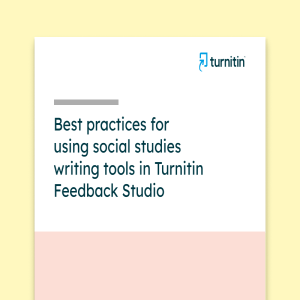No matter where you teach, whether your course is focused on geography, history, economics, or another related subject, the content covered in these courses overlaps - or is explicitly rooted in - the core themes of social studies. Identified by the National Council for the Social Studies (a US-based organization dedicated to the advancement of social studies education), these ten thematic strands and corresponding essential questions were introduced in 1994 to promote inquiry-based instructional approaches in the teaching of social studies content.
Soon after, expectations for 21st-century learning further encouraged shifts in curricula to emphasize supporting students in becoming active participants in the learning process itself. Students are now expected to analyze multiple primary sources, synthesize information, draw conclusions, and justify positions with credible evidence as early as sixth grade. These cognitively rigorous tasks - illustrated primarily in Webb’ s Depth of Knowledge domains three and four - are no easy feat, and even students demonstrating grade-level proficiency in social studies content learning may struggle to express their ideas in formally written responses.
Teaching students how to write for formal, academic purposes is not a skill set that should fall on the shoulders of the social studies teacher alone. However, all educators are accountable for teaching students how to communicate in the context of their discipline, and in social studies, that means teaching students how to formulate and defend positions on a historical topic.
So, how do you keep the focus on social studies content learning while guiding students to communicate effectively in writing?Designing tasks that access the cognitive rigor of domain four (developing arguments, synthesizing information, extended reasoning) takes time and practice for both students and teachers, but here are a few small things you can do to help your students think - and write - like historians.
Cultivate accountable thinkersCollaboration is one of the tenets of 21st-century skills and it is an essential instructional approach for learning social studies concepts. But every seasoned teacher knows that group work comes with its own set of challenges. Domineering personalities overshadow meek (or obstinate) ones, and it’s unclear which students have actually grasped the targeted concepts, and to what degree. Like all instructional approaches, there should be a balance to integrating collaborative discourse with independent thought.
Once students have had opportunities to safely explore concepts, share ideas, and validate theories, instructors should move beyond their collaborative efforts by having each student demonstrate their current level of understanding about a topic. Employ formative assessments - like exit slips and reflection statements - as informal, low-stakes opportunities that require each student to articulate their thoughts in writing. Enhancing their initial collaborative and cognitive efforts with a final (albeit brief) written product helps to solidify the conceptual learning into a concrete idea. At the same time, this small act affords each student much-needed practice in the foundational skills needed to develop formal (and lengthier) arguments later.
Practice foundational skillsWe wouldn’t assume that students arrive at our doors with a proficient understanding of the relationship between human populations and the physical world. Similarly, we can’t assume they have a proficient understanding of writing for historical topics and audiences. To be fair, they do receive direct instruction in argumentative writing in the English classroom. But every discipline has its nuances when it comes to written communication expectations, and it is those nuances that need to be identified, modeled, and practiced in the social studies classroom.
Consider formative writing tasks that ask students to use domain-specific vocabulary in context (“Tweet about colonization from an indigenous person’s perspective”) rather than in isolation (e.g. matching or copying definitions). Moreover, practice the analysis of primary sources long before the first DBQ is due. Provide models for students that list what questions they should be asking the text as they analyze each source, and remove those training wheels as they begin to develop their own questioning techniques. For help getting started, the Library of Congress provides these teacher guides for the different primary source formats (maps, political cartoons, etc.) and this interactive primary source analysis tool that leads students through the source analysis process. For specific lesson ideas, check out these ten simple activities we’ve developed to practice the essential skills of a document-based question.
Communicate clear expectationsJust as you share the ten themes of social studies and apply the corresponding essential questions to each unit of study, students need to have repeated exposure to the conventions of historical writing. Likewise, if we want students to perform to grade-level expectations, we need to share and model what those expectations are and provide feedback to students along the way. Rubrics provide a clear roadmap of task expectations and offer objective descriptions of performance level criteria for both students and teachers. They also let students know what is valued on a particular assignment (i.e. position and evidence only, or is formal/domain-specific vocabulary required?). Consider using the following teacher-created rubrics that are aligned to grade-level expectations for writing in the social studies:
- Social Studies Short Answer (best suited for short, formative writing tasks)
- 6th-8th Grade and 9th-12th Grade Historical Analysis (best suited for DBQs and text-dependent arguments)
- AP US History DBQ and LEQ (aligned explicitly to the APUSH criteria for free-response questions)
When providing feedback to students, be clear in connecting your observations of their performance to the expectations measured in the rubric. Commenting that the essay presents appropriate historical evidence provides much more insight to what the student did well than by saying “Good job!” (For expertly-crafted feedback that corresponds directly to the rubrics above, check out our drag-and-drop Social Studies QuickMark Sets.)
As with the implementation of any new instructional approach, remember to start small and build momentum. If writing tasks such as these are out of students’ comfort zones (or teachers’), acknowledge the challenges and growing pains you experience together. And then keep going. Model and encourage a growth mindset for students as you push through those challenges, and recognize the small victories you notice along the way. (Are students less resistant to writing on demand? That’s important! Are they improving their use of evidence to support ideas? That’s huge!) When students are comfortable with the foundational skills of writing in a social studies context, there will be fewer obstacles to approaching more rigorous tasks like essays and DBQs.
Interested in learning more? Sign up for our upcoming webinar and dive into a deeper discussion on how best to support students’ social studies writing and thinking.
Developing Literate Citizens: Using Writing to Boost Social Studies SkillsIn this webinar, we’ll discuss the ways in which writing can be used as a vehicle to both explore social studies concepts and demonstrate student comprehension. Sharing his perspective on this topic will be Joe Welch, 2020 Pennsylvania Teacher of the Year and 2018 Gilder-Lehrman National History Teacher of the Year. Participants can expect to learn strategies to overcome the challenges of writing in the social studies classroom and to access free resources that can help to increase student success.
Wednesday, March 25th, from 4:00-5:00 pm EDT






